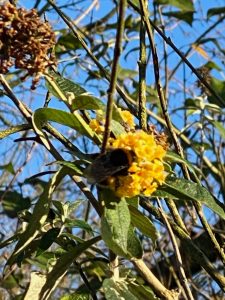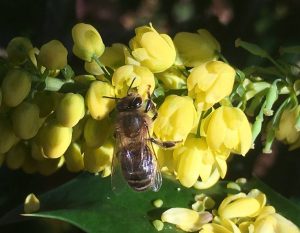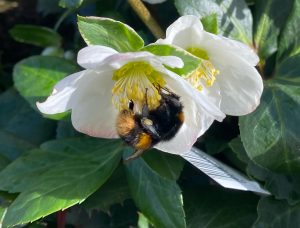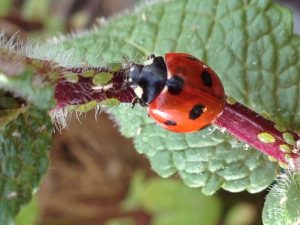
It’s just turned December in the UK and until a few days ago there were still butterflies and bumblebees foraging on the winter shrubs. In my garden my resident wasp nest was still very much active, and there were many late summer flowering plants actually still in bloom, like cosmos and coreopsis and roses. Social media has been awash with late flowers still blooming into winter.
Melding seasons

Far from being a good thing, it actually is a bit unsettling, but imagine what it means to nature and wildlife. Many creatures use temperature and weather to control their lifecycle. The seasons seem to be melding, overlapping and offering unexpected extremes.
Creatures that usually hibernate are active for longer before the cold sets in. While that might mean they have more opportunity to feed up for the winter ahead, they are also more likely to be eaten by predators. Plus it changes the triggers that activate their hibernation behaviour.
But it also means that some creatures are drawn out of their winter slumber by a mild spell in late winter, much earlier than they might otherwise emerge. And then these creatures are then very vulnerable and very dependent on the food available when they venture out from their winter refuge, often hungry and weak.
Knock on effect

You might be wondering what this has got to do with gardens, greenhouses and gardening?? Global warming affects every layer of nature and the food chain. Think back to the extreme heat we had in the summer. Many plants including trees and shrubs struggled to survive and while doing so their flowering, fruiting and making seed may have been affected. So that means less natural food in our gardens for the food chain and even less larval food for some of our pollinators, like butterflies and moths.
It’s all interconnected; an entangled web of life that exists in and around our gardens. If one layer wobbles the whole stack comes tumbling down. And right now there are serious signs of significant wobbles. Headlines scream statistics in the decline of insects, 60% in the last 20 years, but far from being regarded as the canary in the coalmine signal that needs instant remedial attention; many seem to think it’s good news to have less bugs and creepy crawlies. Our language and description of insects reflecting the general lack of appreciation for these underrated creatures, but we undervalue them at our peril.
Already in the UK we have lost 97% of our meadows since the end of the Second World War. For some reason that doesn’t seem to have been screamed out loud from the rooftops either. Let me put it another way. We have 3% left; Just three percent of our flower meadows; aren’t they worth saving? And can our gardens make up some of the difference? Yes and yes. The flowers are a precious source of sugar rich nectar and protein rich pollen for insects. And many of the plants, especially the natives that evolved alongside their pollinator partners are larval food for caterpillars and nesting sites for eggs and larvae.
Supporting nature

As gardeners we have power, but we need to ensure that every season overlaps in and around our gardens, by planting more trees and more shrubs that offer out of season bounty, shelter and protection for garden wildlife too. Wintering flowering plants that span the season offering a pit stop for winter active insects, especially the bumblebees that have chosen to build a nest rather than hibernate. These creatures need a reliable source of nectar and pollen to sustain their winter activity. And indeed set them up for hibernation (torpor), which would be their normal winter behaviour.
Natural food

Fruit, berries and seed are sustenance for wild birds and small mammals that are all part of our garden biodiversity and the natural balance. So after a very hot summer when food is scarce, these creatures may go into winter with less fat reserves than normal making them weaker and more prone to disease, predators and premature demise. We can offer supplementary food for many creatures, widely available from wildlife specialists. But even overwintering creatures may be woken earlier by a mild spell, tricked into emerging when there is still little natural food in the garden. A few sunny days can trick the birds into early nesting behaviour making their parental duties even harder when a cold snap returns, and sometimes sadly worse. In extreme contrasting spells of warm sun and freezing cold inexperienced parents can fail to raise the brood, or one parent can become a meal for a hungry predator, leaving the other parent to attempt to raise the chicks alone. While the birds may be active, insects could be yet to emerge. Many rely on specific plants for their life cycle; especially in terms of larval food. A healthy nest of blue tits needs a thousand caterpillars a day to feed the chicks, that’s a sobering thought for gardeners that reach for pesticides at the first sign of caterpillars. Dump the toxins and live and let live.
Coinciding lifecycles

Many insects overwinter as adults and start to become active in our gardens when the temperature warms. But a false start to spring can create all sorts of problems. For some their emergence coincides exactly with an increase in their food source. Ladybirds for example lay their eggs near plants with populations of aphids; their fantastical larvae eating the plump bugs that have fed on the sugary rising plant sap. The aphids themselves overwinter as eggs on the stems of trees and shrubs hatching out as the plants burst into growth. So the food chain here starts with the plants feeding the aphids and then the aphids feeding the first layer of predators, like the ladybirds, lacewings, birds and even some wasps. Plants are one of the base layers of the food chain. When we stop and remember that we might look more kindly on the nature that broaches our boundaries and chooses to exist in and around our gardens.


